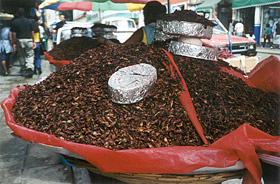 |
 |
 |
 Health & Beauty | June 2005 Health & Beauty | June 2005  
Scientists Work To Bring Back Bug Cuisine
 Wire services Wire services


| | In Aztec times, pest control was accomplished largely by eating bugs rather than spraying them. |
Like many people in his town in the southern Mexico highlands, Gerardo Carrillo looks forward to harvest time in August. That's when he can pick greenish caterpillars off the trees and boil them with a little lime. "They're good," says the 53-year-old gardener. "They taste a little like grasshoppers."

As Mexico's centuries-old tradition of eating bugs becomes more lucrative maguey worms and ant eggs are showing up as exotic fare at expensive restaurants researchers are trying to convince poor villages to cash in on these pests as a means of income.

With a protein content as much as twice that of beef, bugs could also become a welcome diet supplement among the estimated 20 million extremely poor Mexicans who live on incomes of US1 per day or less.

In many towns, especially in southern Mexico, bugs are a regular part of the diet. In Carrillo's home of Zapotitlan de Salinas, 130 miles southeast of Mexico City, residents fry the green caterpillars called cuchama. They sell some, though they're available only a couple of months a year and don't provide much income.

While the spicy, leggy bodies of locusts; the crusty, french-fried caterpillars; or bursting, buttery ant eggs may be an acquired taste, insect cuisine is winning converts in a variety of ways.

Consider locusts, covered in chocolate or sweet sauce, and worms, in Jell-O or clear, hard candy. Invented by biologist Juan García Oviedo, they have been a big hit in test groups over the last decade.

"The kids love them," García Oviedo said of the clear candy with the bug inside. "They tend to eat the candy to get at the bug to see if it's real. Once they find out it's real, they keep on eating anyway."

Seventeen-year-old student Ariel Elurdoy, waiting for a 65-cent taco at a Mexico City street stand, said he would happily try bug food. He, like many Mexicans, has eaten grasshoppers and would be willing to try the rest of the insect and worm kingdom.

"People should be open to trying these things," Elurdoy said. "They're good."

CHANGING MINDSET

Long a food source in Oaxaca, the bug movement is spreading. Farmers on the outskirts of Mexico City were spending large amounts of money on pesticides to kill grasshoppers, García Oviedo said, until they found they could get more money for the edible bugs than for their crops.

"Now, these farmers are planting a cheap kind of corn, just to serve as a trap to catch grasshoppers," he noted. "They've seen that it's better to have a crop with pests."

While the ideas have made it to market studies and consumer testing, they still require seed money. García says he has interest from foreign investors, but has been hamstrung by Mexican food-safety standards that treat insect content as contamination rather than a potential main ingredient.

Officials at the Agriculture Department say insect consumption falls outside regulations because it's a traditional, noncommercial food product.

Researchers note that in Aztec times, pest control was accomplished largely by eating bugs rather than spraying them.

"This could be a cheap food source, while allowing the farmers to take care of their land and avoid biotech crops and pesticides" aimed at eradicating bugs, says business administration professor Idolina Velázquez.

One of her students has already recruited farmers in Tlaxcala state, just east of Mexico City, to raise popular maguey worms year-round. This wrinkly, red-and-white worm really a caterpillar is the kind sometimes found in a bottle of mescal.

Increased availability would improve the market for the sought-after worms fried and sold with butter and garlic for as much as 40 a dozen at some upscale Mexican restaurants, about 15 times the price paid to those who gather them.

And in some villages in southern Mexico, bug "contamination" is hardly accidental: A few ground-up insects are added to hot chile salsa in villages as a nutritional boost.

Dr. Héctor Bourges of the National Nutrition Institute said eating insects was a "sort of return to the distant past" our primate ancestors probably ate them. But he doubts bugs alone could make a big difference in diets of malnourished people.

Even so, García Oviedo hopes to produce more modern, "mixed-bug" products, like grinding up grasshoppers into hot dogs, or enriching tortillas with high-protein bug larvae powder.

"It's just like eating a regular hot dog," he says, "but with five or six times the nutritional value." | 
 | |
 |



